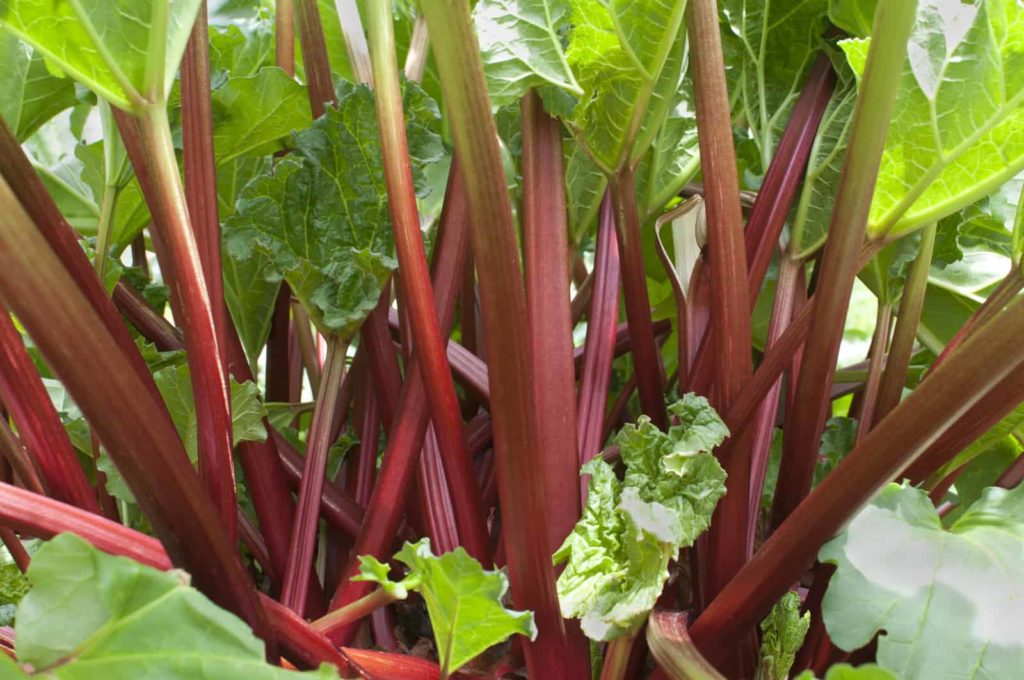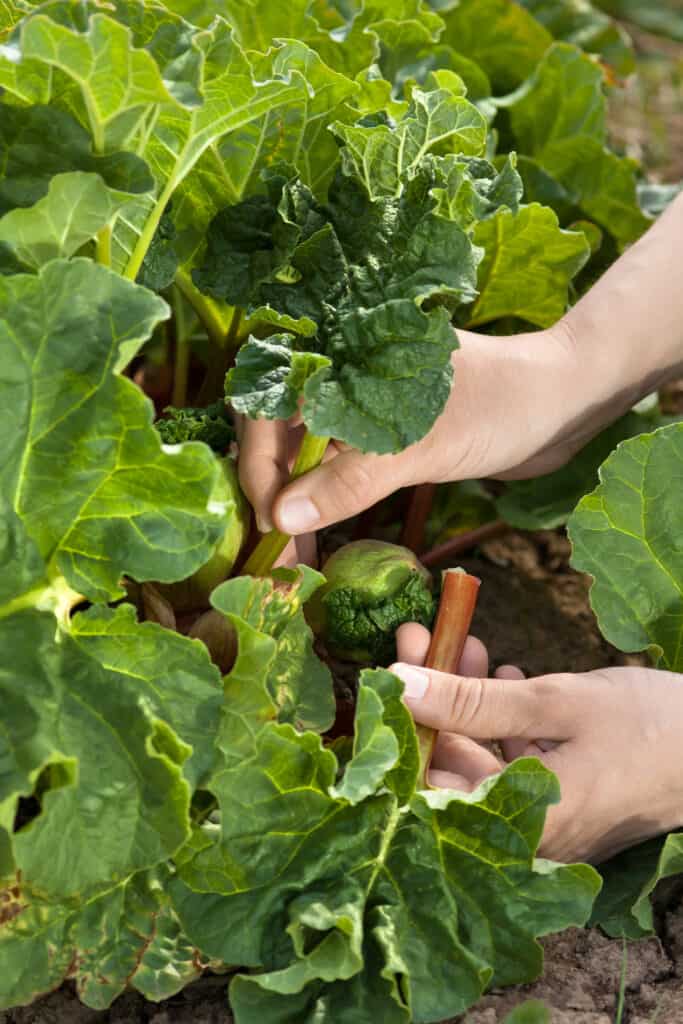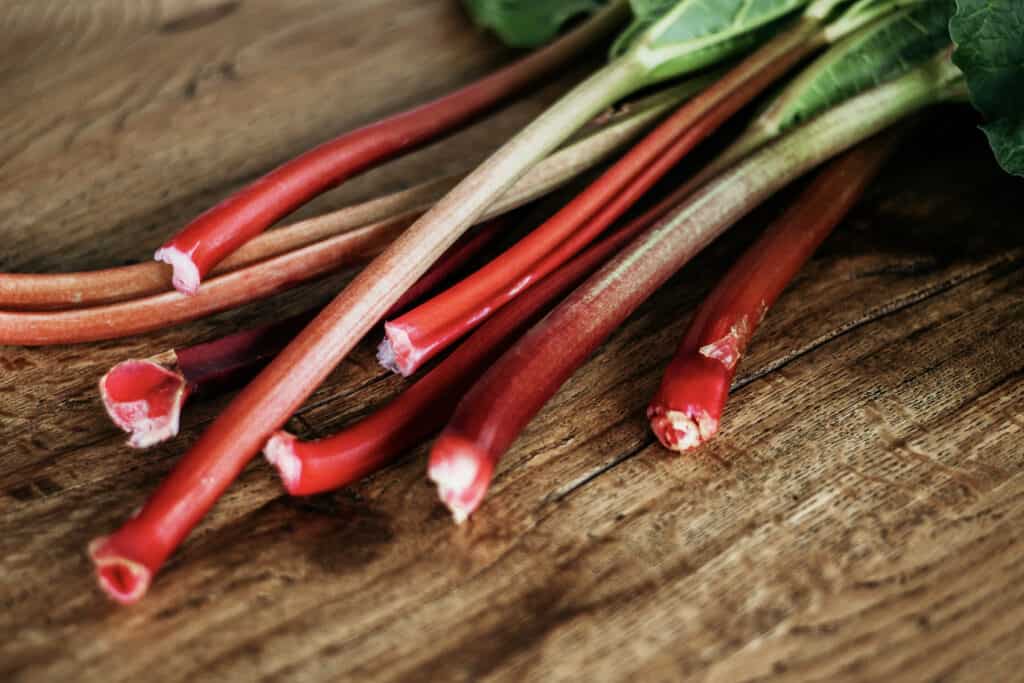Rhubarb is one of the first crops of the year; the plant springs to life when temperatures rise into the 40sF; begin the rhubarb harvest as soon as stalks are ready.
Related article:

Stems harvested in early spring will be the most tender and flavorful. (Rhubarb is naturally tart and is commonly coupled with strawberries.) Do not wait for stalks to get too big around (or too mature)—they can be pithy and tough especially when hit by hot weather or drought. (Pithy stems can be used for stewing, sauces, and jams.)
Kitchen Helpers from Amazon:
- Oster Vegetable Steamer
- Chef’s Knives Set of 6
- EZ Off Jar Opener for Weak Hands
- Pepper Core Remover Stainless Steel
- Kitchen Utensils – Set of 35
- Rachel Ray Non-Stick Cookware 12pcs

When to harvest rhubarb
- Harvest rhubarb stalks when they are about as thick as your finger and at least 8 inches (20 cm) long.
- Stalks 12 to 18 inches (30-45 cm) long and longer will be the tastiest. Mature stalk length varies by variety.
- Color also varieties by variety: cultivars such as ‘Victoria’ and ‘Linneaus’ have green stalks that blush a little red near the base; cultivars such as ‘Ruby’, ‘Valentine’, and ‘Canada Red’ have solid red stalks.
- Rhubarb is a perennial plant. A rhubarb clump will be productive for 20 years or more. Do not harvest rhubarb the first year after planting from seed. The second-year harvest a few stalks over a four-week period. The third year after planting and the following years, harvest as many finger-thick-sized stalks as you like over eight to 10 weeks.
How to harvest rhubarb
- Harvest rhubarb by grasping the stalk firmly near the base then pull and twist gently. You can also cut stalks away with a sharp knife; cut as close to the crown as you can. Leave behind new, short, and thin stalks. Be careful not to injure the central bud which will produce more stalks, and do not cut more than one-third of the stalks away from the plant each year.
- Immediately upon harvesting, trim the leaves from the stalks using a knife and discard the leaves; leaving leaves attached to the stalk will cause the stalks to dry and wilt.
- Rhubarb harvest usually lasts about eight weeks and each plant will yield two to three pounds of stalks. After harvest allow plants to grow new stalks and store energy reserves for the next year. A few stalks can be pulled later in summer but not frequently; it’s best to let the plant gain strength for the following season.
- If plants send up flower stalks remove them right away. Flowering uses energy that could be used for rejuvenating the plant. Plants that flower will be less productive.

How to store rhubarb
- Once in the kitchen cut away the leafy top leaving only the colored stalks. Do not eat raw or cooked; rhubarb leaves and roots contain oxalic acid which can cause convulsions, coma, and death. Leaves are safe to compost.
- Freshly harvested stalks are best for cooking and freezing.
- Store rhubarb in a cold and moist place, 32°-40°F (0°-4°C) and 95 percent relative humidity. Cold and moist storage can be a challenge. Refrigerators provide the cold, but they also dry the air. Wrap rhubarb stalks in a damp cloth or paper towel and put them in a perforated plastic bag in the vegetable crisper drawer of the refrigerator; this will maintain humidity.
- Cut stems will keep in the refrigerator for two to four weeks. Refresh stalks kept in the refrigerator by letting them stand in a glass of water before using it.
- Chopped stems can be frozen in a plastic freezer bag for later use—often with strawberries that come to harvest after rhubarb.
Rhubarb articles at Harvest to Table:
How to Harvest and Store Rhubarb
Tasty Ways to Cook and Serve Rhubarb
Garden Planning Books at Amazon:
- Vegetable Garden Almanac & Planner
- Kitchen Garden Grower’s Guide Vegetable Encyclopedia
- Vegetable Garden Grower’s Guide
- Tomato Grower’s Answer Book
More harvest tips:
Learn when and how to harvest your favorite vegetables for the best flavor and texture. Get storage tips for each crop. Click on the vegetable you are growing below.
- Artichoke
- Arugula
- Asparagus
- Beans
- Beets
- Broccoli
- Brussels Sprouts
- Cabbage
- Cantaloupe — Melons
- Carrots
- Cauliflower
- Celery
- Chard
- Collards
- Corn, Sweet
- Cucumbers
- Eggplant
- Endive and Escarole
- Garlic
- Jerusalem Artichoke
- Kale
- Kohlrabi
- Leeks
- Lettuce
- Melons
- Okra
- Onions
- Parsnips
- Peas
- Peppers
- Potatoes
- Pumpkins
- Radicchio
- Rhubarb
- Rutabaga
- Spinach
- Squash, Summer
- Squash, Winter
- Sunchokes
- Sweet Potato
- Swiss Chard
- Tomatillo
- Tomatoes
- Turnips
- Watermelon















